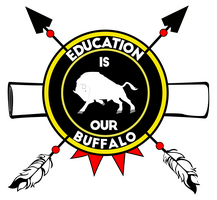Many years ago, a young Piegan warrior was noted for his bravery. When he grew older and more experienced in war, he became the war-chief for a large band of Piegan warriors.
A little while after he became the war-chief, he fell in love with a girl who was in his tribe, and they got married. He was so in love with her that he took no other wives, and he decided not to go on war parties any more. He and his wife were very happy together; unusually so, and when they had a baby, they were even happier then.
Some moons later, a war party that had left his village was almost destroyed by an enemy. Only four men came back to tell the story.
The war-chief was greatly troubled by this. He saw that if the enemy was not punished, they would raid the Piegan camp. So he gave a big war feast and asked all of the young men of his band to come to it.
After they had all eaten their fill, the war-chief arose and said to them in solemn tones:
"Friends and brothers, you have all heard the story that our four young men have told us. All the others who went out from our camp were killed by the enemy. Only these four have come back to our campfires. Those who were killed were our friends and relatives.
We who live must go out on the warpath to avenge the fallen. If we don't, the enemy will think that we are weak and that they can attack us unhurt. Let us not let them attack us here in the camp.
I will lead a party on the warpath. Who here will go with me against the enemy that has killed our friends and brothers?"
A party of brave warriors gathered around him, willing to follow their leader. His wife also asked to join the party, but he told her to stay at the camp.
"If you go without me," she said, "you will find an empty lodge when you return."
The chief talked to her and calmed her, and finally convinced her to stay with the women and children and old men in the camp at the foot of a high mountain.
Leading a large party of men, the chief rode out from the village.
The Piegans met the enemy and defeated them but their war-chief was killed. Sadly, his followers carried the broken body back to the camp.
His wife was crazed with grief. With vacant eyes she wandered everywhere looking for her husband and calling his name. Her friends took care of her, hoping that eventually her mind would become clear again and that she could return to normal life.
One day, though, they could not find her anywhere in the camp. Searching for her, they saw her high up on the side of the mountain, the tall one above their camp. She had her baby in her arms.
The head man of the village sent runners after her, but from the top of the mountain she signaled that they should not try to reach her.
All watched in horror as she threw her baby out over the cliff and then herself jumped from the mountain to the rocks far, far below.
Her people buried the woman and baby there among the rocks. They carried the body of the chief to the place and buried him beside them.
From that time on, the mountain that towers above the graves was known as Minnow Stahkoo, "the Mountain of the Chief", or "Chief Mountain".
If you look closely, even today, you can see on the face of the mountain the figure of a woman with a baby inn her arms, the wife and child of the chief.
Chief Mountain is a mountain in Glacier National Park.
Go Back To: Blackfoot Nation
